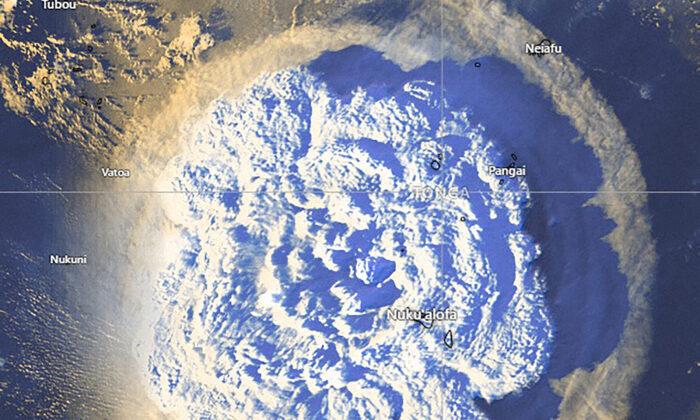The HMAS Adelaide has delivered helicopters and engineering equipment from Australia to Tonga to help with logistics and distribution of humanitarian and medical supplies after the Jan. 15 eruption of a volcano, and subsequent tsunami devastated the Pacific island country.
Australia has sent 40 tonnes worth of relief supplies to Tonga, including shelter materials, water and sanitation supplies, equipment to restore communications, and personal protective equipment for people clearing ash.

Foreign Minister Marise Payne announced that Australia would be widening its support with a further $2 million ($3.2 million) to help restore power and communications, and through the storage and delivery of relief supplies, as well as further recovery efforts on the outer islands most affected.
The Hunga Tonga-Hunga-Ha'apai volcano had been spewing ash and smoke for weeks, but the usual east-south-easterly winds carried them away from Tonga until the wind changed direction on Jan. 14, the day before the eruption.

“There were very loud cracks not experienced in our lived experiences since antiquity—and the elders have lived through a few eruptions and national evacuations of their own. Glass and curtains were blown off the windows in places.”
The explosion was “loud enough for even the deaf to hear,” and although the early warning system failed, a tsunami warning the day before had people on alert, and they quickly sought shelter at higher ground.

The plume of smoke shot straight up from the horizon into the sky until it couldn’t be seen anymore.
“It’s almost as if it was erupting into space itself. Then the huge, vague shadow of dust mushroomed behind the heavens and covered half the sky,” Motulalo said.
The first waves arrived shortly after the shockwaves, overrunning the western shore, about two miles wide, and rushing overland and out to sea on the other side.
An hour or so after the eruption, small volcanic pumice and pebbles, around half a centimetre, made landfall, followed by the ash and gusty winds that picked up and threw debris everywhere.
“This forced cars full of women and children to close their windows, which made the insides of cars like small ovens,” Motulalo said.
The internet, communications, and power soon went out after the piling ash caused the electricity grids transformers to short.
“And so we were in a darkness with an orange-reddish hue, at the hilltops and evacuation centers inland,” he said.

U.S. cable company SubCom has advised that it will take several weeks for Tonga’s cable connection to be repaired, according to the New Zealand government.
“It was almost Biblical: the strong gusts, the stinging, falling pebbles and the blinding ash were accompanied by the wailing of women and the screeching cries of babies and infants—and the whispers among fathers and sons standing guard outside their vehicles that the waves have wiped out part of the island and are now heading their way.”
The fear and hot weather reminded Motulalo of a picture of Sheol, described in the Hebrew Bible as a place of darkness to which all the dead go.
“If there was a picture of Sheol where there’s crying and gnashing of teeth, that would probably be the closest I’d get,” he said.
But after a couple of hours the ash clouds “waned” and reduced to “sprinkles” and a few more hours later, it became apparent to those sheltering that the waters had receded.
Two Tongan nationals and one British national died in the disaster.





